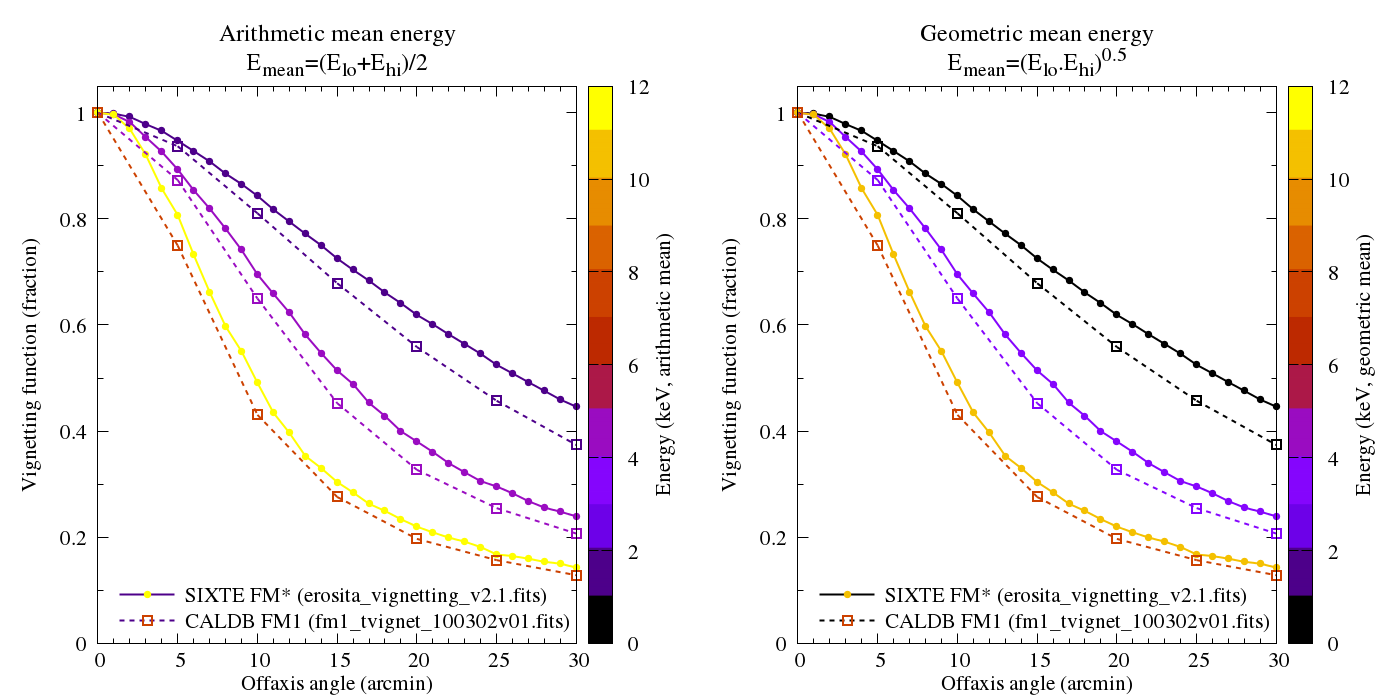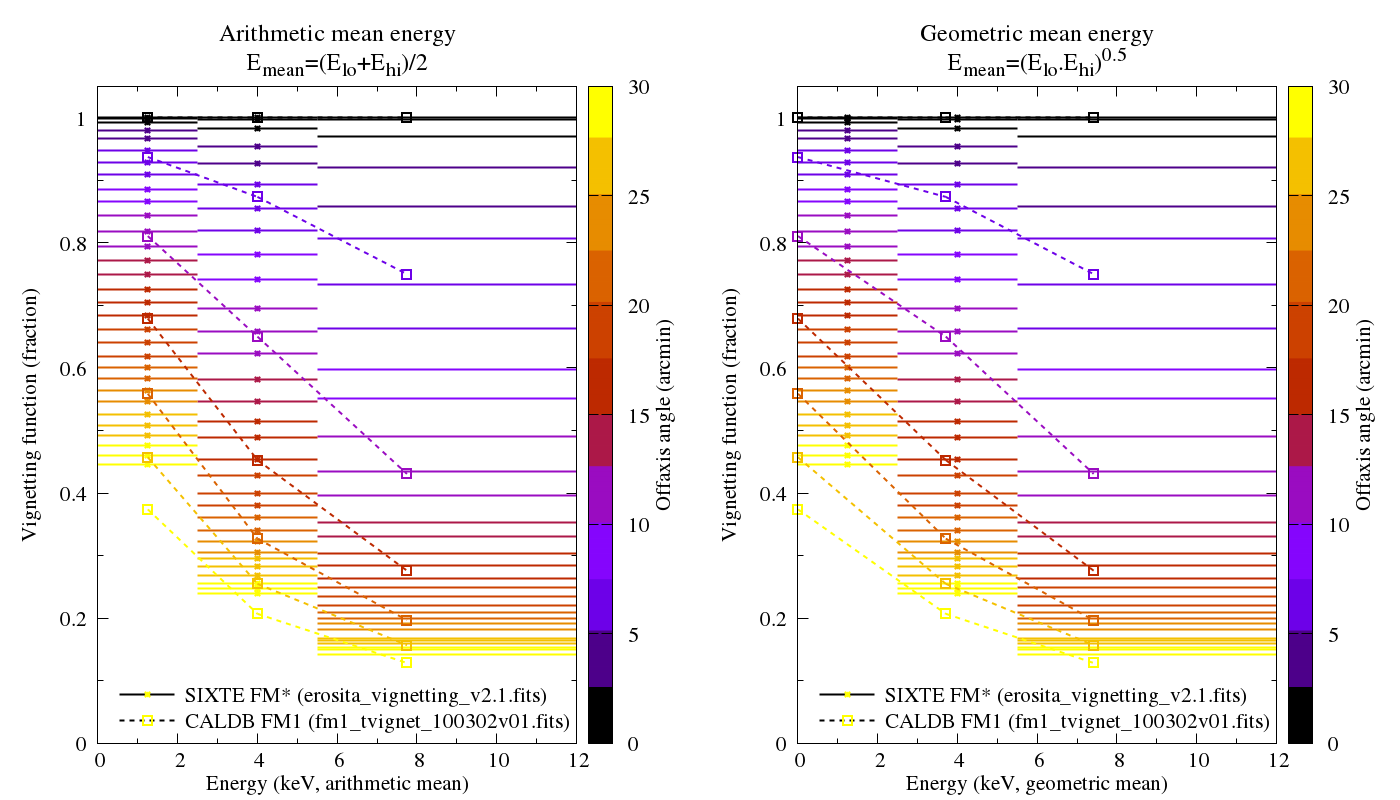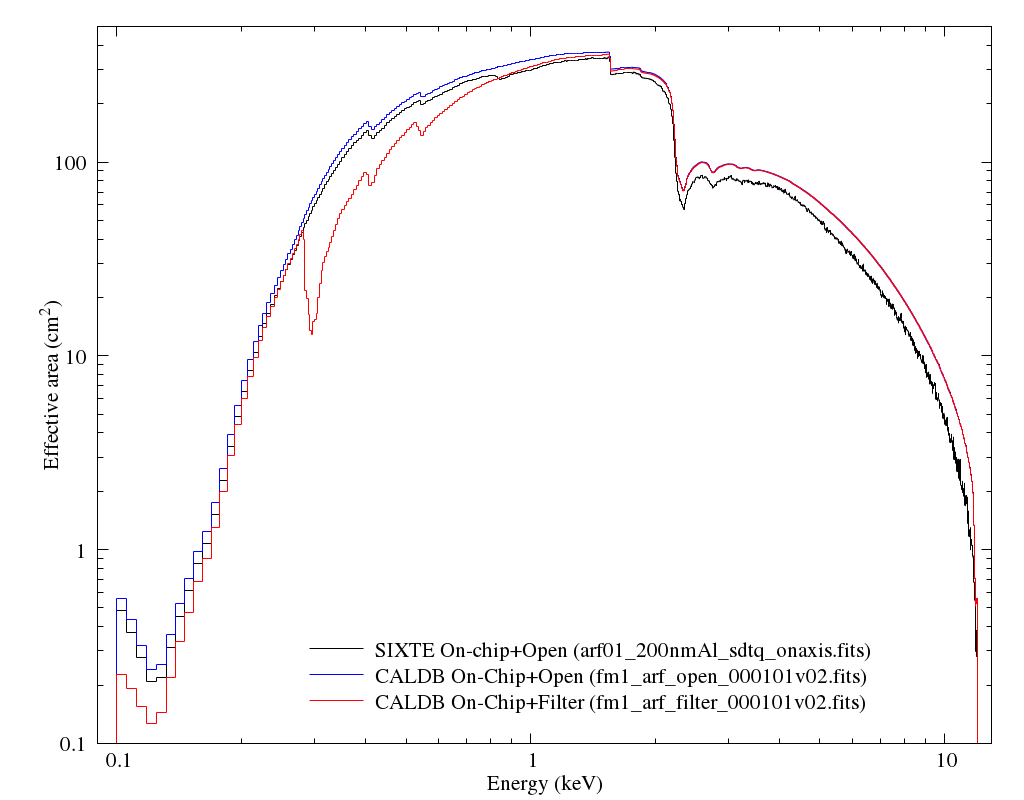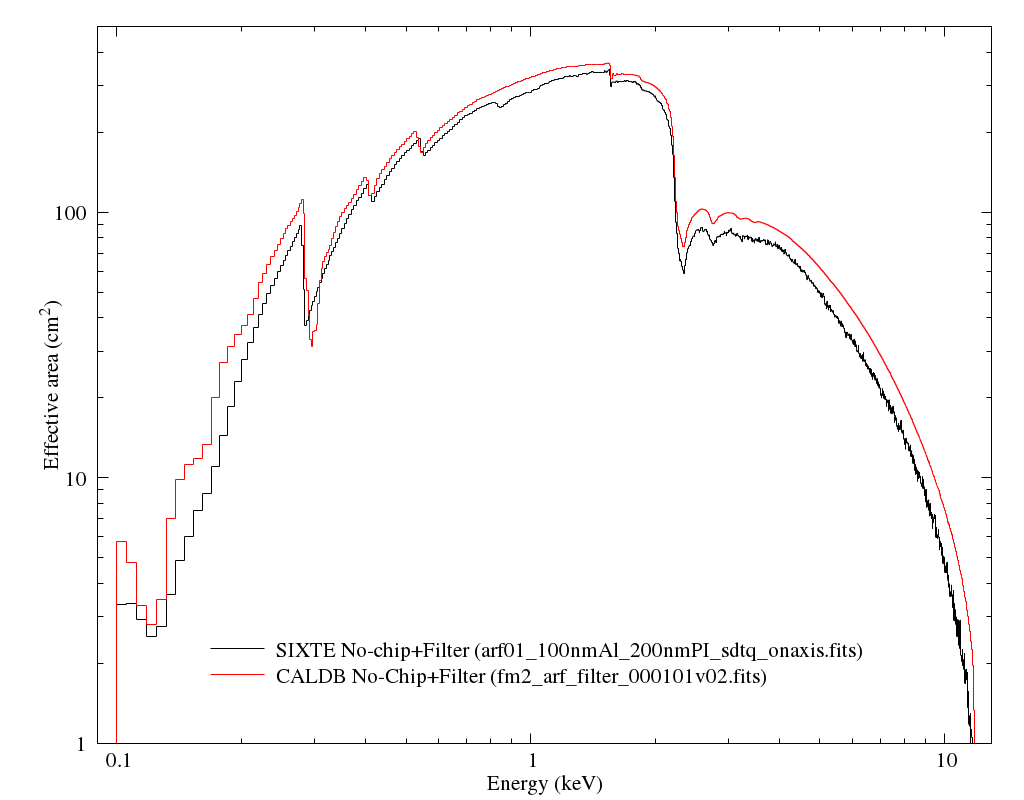|
Size: 2551
Comment:
|
Size: 4027
Comment:
|
| Deletions are marked like this. | Additions are marked like this. |
| Line 9: | Line 9: |
| * Comparison between [[http://www.sternwarte.uni-erlangen.de/research/sixte/downloads/sixte/instruments/instruments_srg-1.4.0.tar.gz|SIXTE instrument description v1.4.0]] vs eSASS CALDB as at 15/02/2018 * Vignetting model (SIXTE: erosita_vignetting_v2.1.fits, eSASS: fm1_tvignet_100302v01.fits) * SIXTE model is tabulated at 31 offaxis angles, eSASS version at only 7 * SIXTE model is tabulated over 3 energy ranges: 0.0-2.5, 2.5-5.5 and 5.5-20 keV, eSASS uses energy ranges: 0.0-2.5, 2.5-5.5 and 5.5-10 keV * differences in the values of the vignetting function are illustrated in the figures below: |
=== Vignetting model (SIXTE: erosita_vignetting_v2.1.fits, eSASS: fm1_tvignet_100302v01.fits) === '''Comparison between [[http://www.sternwarte.uni-erlangen.de/research/sixte/downloads/sixte/instruments/instruments_srg-1.4.0.tar.gz|SIXTE instrument description v1.4.0]] vs eSASS CALDB as at 15/02/2018''' * SIXTE model is tabulated at 31 offaxis angles, eSASS version at only 7 * SIXTE model is tabulated over 3 energy ranges: 0.0-2.5, 2.5-5.5 and 5.5-20 keV, eSASS uses energy ranges: 0.0-2.5, 2.5-5.5 and 5.5-10 keV * SIXTE and CALDB both use identical vignetting functions for all FMs * differences in the values of the vignetting function are illustrated in the figures below: |
| Line 16: | Line 19: |
| [[br]] | <<BR>> |
| Line 19: | Line 22: |
| * Effective area curve (ARF) * TBD |
=== Effective area curve (ARF) === '''Comparison between [[http://www.sternwarte.uni-erlangen.de/research/sixte/downloads/sixte/instruments/instruments_srg-1.4.0.tar.gz|SIXTE instrument description v1.4.0]] vs eSASS CALDB as at 15/02/2018''' * Default SIXTE setup has two types of ARF: * On-chip 200nm Al filter layer and open external filter -> FM1, FM3, FM4, FM6, FM7 -> arf01_200nmAl_sdtq_onaxis.fits * No On-chip filter plus 100nm Al + 200nm PI external filter (on filter wheel) -> FM2, FM5 -> arf01_100nmAl_200nmPI_sdtq_onaxis.fits * CALDB contains three types of ARF: * On-chip filter + open external filter -> FM1, FM3, FM4, FM6, FM7 -> e.g. fm1_arf_open_000101v02.fits * On-chip filter + external filter (on filter wheel) -> FM1, FM3, FM4, FM6, FM7 -> e.g. fm1_arf_filter_000101v02.fits * No on-chip filter + external filter (on filter wheel) -> Fm2, FM5 -> e.g. fm2_arf_filter_000101v02.fits * SIXTE and CALDB both use identical vignetting functions for groups of FMs (On-chip group: FM1, FM3, FM4, FM6, FM7; No on-chip group: FM2, FM5) * differences in the values of the ARF curves are illustrated in the figures below: {{attachment:compare_arfs_onchip.png|Comparison of ARFs for Telescope modules with on-chip filters (FM1, FM3, FM4, FM6, FM7) |width=1000}} <<BR>> {{attachment:compare_arfs_nochip.png|Comparison of ARFs for Telescope modules with on-chip filters (FM2, FM5)|width=1000}} |
Description of known differences between SIXTE and eSASS
This page is intended as a place to document the known differences between how the SIXTE simulation code models the response of eROSITA versus the assumptions in the eSASS code, particularly within SRCTOOL.
Code changes with time, so please include both the SIXTE and the eSASS version numbers to any comments, and please add your initials.
Differences in calibration files
Vignetting model (SIXTE: erosita_vignetting_v2.1.fits, eSASS: fm1_tvignet_100302v01.fits)
Comparison between SIXTE instrument description v1.4.0 vs eSASS CALDB as at 15/02/2018
- SIXTE model is tabulated at 31 offaxis angles, eSASS version at only 7
- SIXTE model is tabulated over 3 energy ranges: 0.0-2.5, 2.5-5.5 and 5.5-20 keV, eSASS uses energy ranges: 0.0-2.5, 2.5-5.5 and 5.5-10 keV
- SIXTE and CALDB both use identical vignetting functions for all FMs
- differences in the values of the vignetting function are illustrated in the figures below:


Effective area curve (ARF)
Comparison between SIXTE instrument description v1.4.0 vs eSASS CALDB as at 15/02/2018
- Default SIXTE setup has two types of ARF:
On-chip 200nm Al filter layer and open external filter -> FM1, FM3, FM4, FM6, FM7 -> arf01_200nmAl_sdtq_onaxis.fits
No On-chip filter plus 100nm Al + 200nm PI external filter (on filter wheel) -> FM2, FM5 -> arf01_100nmAl_200nmPI_sdtq_onaxis.fits
- CALDB contains three types of ARF:
On-chip filter + open external filter -> FM1, FM3, FM4, FM6, FM7 -> e.g. fm1_arf_open_000101v02.fits
On-chip filter + external filter (on filter wheel) -> FM1, FM3, FM4, FM6, FM7 -> e.g. fm1_arf_filter_000101v02.fits
No on-chip filter + external filter (on filter wheel) -> Fm2, FM5 -> e.g. fm2_arf_filter_000101v02.fits
- SIXTE and CALDB both use identical vignetting functions for groups of FMs (On-chip group: FM1, FM3, FM4, FM6, FM7; No on-chip group: FM2, FM5)
- differences in the values of the ARF curves are illustrated in the figures below:


- PSF model
- TBD
- Redistribution function (RMF)
- TBD
Differences in modelling the instrument
- (TD) Just out of field sources (SIXTE v2.1.1 - SRCTOOL v*)
Difference: SIXTE generates counts for a point source only if its sky coordinates fall inside the detector footprint, however SRCTOOL assumes that sources just outside the detector footprint will create detectable counts due to the finite PSF.
Consequence: If one uses SIXTE to simulate a source observed in an eROSITA scan, and examines the lightcurve produced by SRCTOOL, the source will appear to be too faint as it crosses into and out of the detector FoV.
Notes: The behaviour of SIXTE for extended sources near the edge of the FoV has not been checked by me (TD).
- (TD) Pileup (SIXTE v* - SRCTOOL v*)
Difference: SIXTE has a detailed model of pileup, SRCTOOL makes no attempt to correct for pileup (by design)
Consequence: When using SRCTOOL to analyse simulated eROSITA observations of very bright sources (made via SIXTE) will give misleading results (sources will appear to be too faint, too hard, and will have spurious variability)